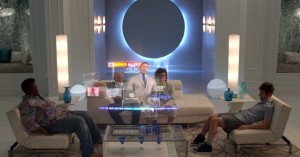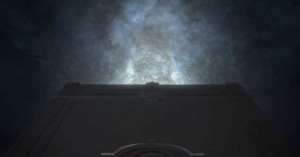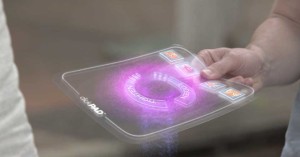
One of the most crucial effects for the sci-fi adventure was the water vortex that would serve as their mode of transit to the future from their magical hot tub. To intensify this time portal for the sequel, the Zoic team crafted a water vortex that becomes a sustained column of water and light. Passionino worked with cinematographer Declan Quinn to create an animated LED light system to simulate the interactive light from the water vortex that would later be augmented in post.
 The CG team utilized a wide array of tools and software to delve into the dynamics of water in order to create vortex. Once the main column of the of the vortex was created using Realflow, additional elements of foam, splashes, droplets, blobs, steam, mist and debris were created in Maya with Phoenix, Fury and Vray. Additional render passes for subsurface, refraction, depth, luminosity and light rays were created along with an RGB lighting utility pass to give further flexibility for the compositors to light the CG in 2D. To connect the chaos on the ground to the sky, a swirling mass of volumetric clouds were created with Phoenix and rendered in Vray.
The CG team utilized a wide array of tools and software to delve into the dynamics of water in order to create vortex. Once the main column of the of the vortex was created using Realflow, additional elements of foam, splashes, droplets, blobs, steam, mist and debris were created in Maya with Phoenix, Fury and Vray. Additional render passes for subsurface, refraction, depth, luminosity and light rays were created along with an RGB lighting utility pass to give further flexibility for the compositors to light the CG in 2D. To connect the chaos on the ground to the sky, a swirling mass of volumetric clouds were created with Phoenix and rendered in Vray.
Another central effect for the comedy was the visualization of a character’s existence being threatened due to the time travel. To show Lou (Corddry) flickering – in danger of not surviving long enough to reach 2024 – clean plates were shot on set for each of the scenes where the effect would be needed and moments where the actors crossed. In postproduction, compositors painted sections back in that were needed and added multiple layers of static, distortion and chromatic aberration to the images to create the final effect.
 Since this installment of the sci-fi comedy travels to the future, the Zoic team also crafted a number of holographic elements, including a holographic television and holographic phone communications. To create a television that would cater to the ever-dwindling attention spans of viewers, Zoic worked with Pink to create a holographic television that would allow for an endless number of channels to display simultaneously. Motion graphics designer Jeremy Price crafted the multi-planed interface and composited the content into the windows to create an interactive holographic device that was activated by touch. This design was also used for telecommunications throughout the film.
Since this installment of the sci-fi comedy travels to the future, the Zoic team also crafted a number of holographic elements, including a holographic television and holographic phone communications. To create a television that would cater to the ever-dwindling attention spans of viewers, Zoic worked with Pink to create a holographic television that would allow for an endless number of channels to display simultaneously. Motion graphics designer Jeremy Price crafted the multi-planed interface and composited the content into the windows to create an interactive holographic device that was activated by touch. This design was also used for telecommunications throughout the film.





